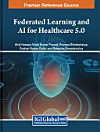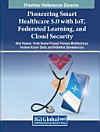Digital Twins for Sustainable Healthcare in the Metaverse
About this ebook
Digital Twins for Sustainable Healthcare in the Metaverse emerges as a solution to these pressing challenges, offering a forward-thinking approach to revolutionize healthcare delivery. By exploring the integration of digital twin (DT) technology with the consumer health metaverse (MCH), alongside artificial intelligence (AI), machine learning (ML), and other cutting-edge innovations, this book provides a roadmap for transforming healthcare systems and processes. From enhancing data management and visualization techniques to leveraging blockchain technology for data privacy, each chapter offers actionable insights to address the complexities of modern healthcare delivery.
About the author
|Subrata Chowdhury - Editor|Dr. Subrata Chowdhury is currently working as an associate professor in the Department of Computer Science and Machine Learning at Sreenivasa Institute of Technology and Management Studies, Chittoor, AP. He has worked in the R&D development of the IT industry for more than 5 years. He has completed many projects in the industry with much dedication and perfect time limits. He has handled various projects in AI, blockchain, and cloud computing for national and international clients. He published four books from 2014 to 2019 on the domestic market, and he edited two books for international publishers like CRC, River, etc. He has been involved in the organizing committee and technical program committee and has acted as a guest speaker for more than 10 conferences and webinars. He has also reviewed and evaluated more than 50 papers in conferences, journals, book chapters, and science articles in the areas of AI, data science, IoT, blockchain, and cloud computing for CRC, Springer, Elsevier, Emerald, IGI-Global, and Inder Science Publishers. He is the Associate Editor of JOE, IET, Wiley, and other journals. He has taken part in various workshops, webinars, and FDPs as a resource person. He has published more than 100 research papers, copyrights, and patents to his credit. He has been awarded by the International and National Science Societies for his eminent contribution to the R&D field. He has received travel grants, and he is also a member of the IET, IEEE, ISTE, ACM, and other professional bodies.
Seifedine Kadry has a bachelor’s degree in 1999 from Lebanese University, an MS degree in 2002 from Reims University (France) and EPFL (Lausanne), Ph.D. in 2007 from Blaise Pascal University (France), an HDR degree in 2017 from Rouen University (France). His research currently focuses on Data Science, medical image recognition using AI, education using technology, and applied mathematics. He is an IET Fellow and IETE Fellow, member of European Academy of Sciences and Arts. Professor Kadry's most significant contribution to medical image analysis and processing is his thorough and rigorous approach to developing and documenting different Deep Learning models to analyze medical images for various diseases. He was one of the first researchers to develop a classification methodology to classify Focal and Non-Focal EEG by combining optimized entropy features towards classification. Therefore, he showed that entropy features are very good concerning EEG classification for better classification accuracy. In this approach, the maximum computation time of the selected features is 0.054 seconds, opening the window for real-time processing. Furthermore, Prof. Kadry was the first to introduce a heart rate measuring strategy using LAB color facial video. RGB videos are used by most of the nonintrusive-based systems as it is appropriate for experiments. Still, they must be developed extensively before being implemented in real-time applications. Furthermore, heart rate monitoring using RGB videos is inefficient outdoors because light significantly contributes to RGB videos. The proposed algorithm using LAB, The presented algorithm seems to be very powerful, quite practical, and easy to use in the regular observation of home care patients. His work on developing machine learning and deep learning models to analyze medical images has encouraged the development of AI models for the Covid-19 pandemic. His team proposes a deep learning framework for classifying COVID-19 pneumonia infection from normal chest CT scans. In this regard, a 15-layered convolutional neural network architecture is developed, which extracts deep features from the selected image samples – collected from the Radiopeadia. Deep features are collected from two different layers, the average global pool and fully connected layers, which are later combined using the max-layer detail (MLD) approach. Subsequently, a Correntropy technique is embedded in the main design to select the most discriminant features from the features pool. Finally, a one-class kernel extreme learning machine classifier is utilized for the final classification to achieve an average accuracy of 95.1% and sensitivity, specificity & precision rate of 95.1%, 95%, & 94%, respectively.
Robertas Damaševičius (Member, IEEE) received the Ph.D. degree in informatics engineering from the Kaunas University of Technology, Lithuania, in 2005. He is currently a Professor with the Department of Applied Informatics, Vytautas Magnus University, Lithuania, and an Adjunct Professor with the Faculty of Applied Mathematics, Silesian University of Technology, Poland. He also lectures software maintenance, human–computer interface, and robot programming courses. He is the author of more than 500 articles and a monograph published by Springer. His research interests include sustainable software engineering, human–computer interfaces, assisted living, and explainability. He is also the Editor-in-Chief of the Information Technology and Control journal. He has been the Guest Editor of several invited issues of international journals, such as BioMed Research International, Computational Intelligence and Neuroscience, the Journal of Healthcare Engineering, IEEE A ccess, Sensors, and Electronics [Editor]





